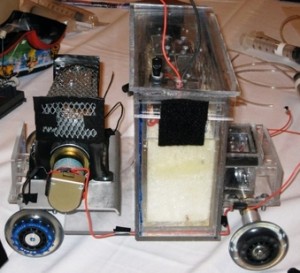
Students will put ‘chem-car’ to national test
Posted: June 09, 2010

Using ethanol, sulfuric acid and water as power sources, ASU engineering students designed and built this “Chem-E-Car” that has earned them a place in a national student competition sponsored by the American Institute for Chemical Engineers.
A team of ASU students will showcase their technological skills in a national competition organized by the American Institute of Chemical Engineers, one of the world’s leading professional engineering organizations.
They’ll take part in the National Chem-E-Car Competition during the institute’s annual student conference in Salt Lake City, Utah, Nov. 6 and 7.
The team earned its way to the national competition by finishing in third place overall this spring in the institute’s Rocky Mountain Region Chem-E-Car Competition at the University of New Mexico.
The contest requires teams to design and construct chemically powered shoebox-sized vehicles that produce a chemical reaction to start and stop the vehicles. Teams are told only hours before the start of competition about the distance their cars must travel and the amount of cargo that each vehicle will carry.
Representing ASU will be chemical engineering undergraduates Jacob Lenzi, Luis Moya, Tara Smith, Kyle Foster, Alison Davis, Brian Anderson, Andrew Chelsy, Mike Rosauri, and mechanical engineering undergraduate Mark Garrison.
At the regional event, they took first place for most creative vehicle design and first place in the project poster presentation part of the competition.
Engineering assistant professor Bryan Vogt, faculty adviser to the ASU student chapter of the American Institute of Chemical Engineers, explains that the team’s performance is an exceptional accomplishment.
Many successful teams work from previous models as a starting point for car design, Vogt says. The ASU team didn’t have a previously designed car from which to start, so “the car that qualified for nationals was built fully from scratch,” he says.
“Qualifying for the National Chem-E-Car Competition is very exciting for the entire team,” says second-year competitor Smith. “Our success in the regional competition validated the tremendous amount of hard work we put in over the spring semester. The car consumed about eight hours a week of my life for the entire school year, so it feels really good that it has performed so well,” says Smith.
The team hand built the car in a mechanical engineering machine shop, with assistance from Fred Pena, a research lab manager in the School for Engineering of Matter, Transport and Energy, a part of ASU’s Ira A. Fulton Schools of Engineering.
Students learned to advanced equipment and about designing problem-solving methods. They constructed three “chem-cars” before they were satisfied they had a vehicle ready for competition.
“It’s been a lot of work, but the hands- on experience has been priceless,” says Smith. “It really seals in our memories what we have been learning in class, and gives us a creative outlet.”
The team’s vehicle runs through the use of thermal junctions that produce electricity by creating a heat transfer through the junctions. The team created a 110 Celsius temperature difference by using dry ice in an ethanol bath on one side, and the dissociation of sulfuric acid in water on the other.
“The Chem-E-Car’s success is proof of the value of the education I received in engineering at ASU. I’ve learned a lot by building the car,” Smith says.
“These types of projects provide important opportunities for hands-on experiences outside the classroom,” says Kyle Squires, director of the School for Engineering of Matter, Transport and Energy. “That this team has done so well without starting from a previously designed vehicle speaks highly of their hard work and dedication. We’re looking forward to seeing them compete in the finals.”
The team received support from the USG Corp., the Ira A. Fulton Schools of Engineering, and several local companies, including Schlumberger, Abbie Gregg Inc., Air Products and Salt River Project.
Written by Jessica Graham



































